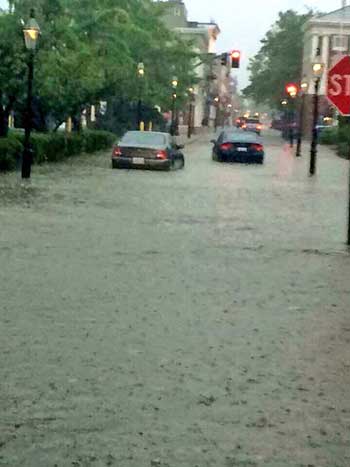Newport-Aquidneck

Flooding in Newport's Pont Neighborhood as a result of the storm on February 9, 2016.

A downpour on July 1, 2015 left some motorists on Thames Street up to their hubcaps in stormwater, a condition all too familiar in many low lying areas of the city.
Need for Stormwater Management
The need for stormwater management is magnified in Newport by the city’s combined sewer overflows (CSO). Newport’s combined system mixes rain water and wastewater in portions of the city’s wastewater collection system. During significant rain events excessive amounts of rain water enter the sanitary sewer system. The capacity of the sanitary sewer is exceeded, and the excess flow, a mixture of sewage and rain water, is discharged into Newport Harbor. This is referred to as a combined sewer overflow. The Newport system overflows at two locations: (1) The Wellington Avenue CSO Facility’s outfall is northeast of the Ida Lewis Rock and (2) the Washington Street CSO Facility outfall is east of the north end of Goat Island. The overflow problem is exacerbated by connections from catch basins, roof drains, yard drains, and sump pumps that collect rainwater or ground water and are then connected to the sanitary sewer system rather than a storm drain system or being discharged into the ground. The City’s Department of Utilities is working in targeted neighborhoods, encouraging homeowners to disconnect downspouts from the sanitary system. These homeowners are given information on rain gardens and other green infrastructure solutions, but additional outreach and education are needed to encourage wide implementation of strategies that absorb rainwater rather than allow it to run off. The story "Runoff Still Threatens Water On Aquidneck Island" on the RI Public Radio website talks more about these issues.
Coastal Flooding Risks
Historic neighborhoods throughout Newport increasingly face flooding from coastal storms and rain runoff. The historic Point neighborhood and Storer Park include many older homes, several owned by the Newport Restoration Foundation. Storer Park was established in 1940 by three women in Newport who were determined to preserve historic homes and create recreational space for children to enjoy. Storer Park sits just north of the Goat Island Causeway and south of the Newport Bridge.
Stormwater management in upland areas that drain to Storer Park exacerbate coastal flooding in the neighborhood. In Newport, rainfall, snowmelt, and wet weather storm events flow over hard surfaces, instead of soaking into the ground, creating water quality and flooding challenges. This stormwater runoff collects pollutants such as heavy metals, nutrients, sediment, and pathogens as it flows to the storm sewer system and is discharged to local waterways. In this neighborhood, stormwater systems provide no treatment.
Newport’s “Gray” Infrastructure
Newport manages stormwater in the Point with “gray” infrastructure — gutters, basins, and pipes that transport stormwater quickly to the bay. Cities throughout Rhode Island lack staff and funding to maintain their stormwater infrastructure. In Newport, storm drains frequently fill with de-icing sand and other sediment, which causes rain to back up, flooding historic streets, homes, and businesses in the Point neighborhood. In addition, the stormwater flows into Storer Park, which is also vulnerable to bay flooding and from the rising tides and storm surges.
Efforts are underway to manage stormwater in this section of Newport. In 2013 with the generous support of the Van Beuren Foundation work has been done to study three areas in the city, including the Point. The project focuses on neighborhoods threatened by rising sea levels, storm surges, and increasingly intense storms because of climate change. It also promotes and recommends best techniques to remediate these problems. With the receipt $1.6 million in federal aid in 2014, the Rhode Island Public Transit Authority (RIPTA) is rebuilding and strengthening infrastructure damaged by Superstorm Sandy at the Gateway Center. This project includes the implementation of “green” stormwater management systems. The Green Infrastructure Coalition project will explore connections between these projects and work to build a neighborhood-wide system.
Green Infrastructure Jobs
Green infrastructure can create jobs while increasing the resilience of the built environment to climate change. Throughout the state and region, decision makers are considering how to respond to climate change, looking at the challenges posed by rising sea levels, intense storms and rising temperatures. Newport leaders like Paul Carroll recognize that climate change poses economic opportunities as well as challenges. He has spoken at forums hosted by leaders promoting state climate resilience legislation, describing how Newport will be working in partnership with the RI Nursery and Landscape Association to promote green infrastructure as a resilience strategy, particularly in the city’s north end. Understanding the economic impacts of the work ahead is important, and the Stormwater Coalition will be working to create job tracking metrics and systems to monitor and document the job impacts of the governor’s bond proposal. These systems will also be used to track the benefits of green infrastructure projects identified through this project.